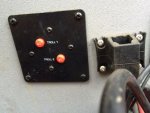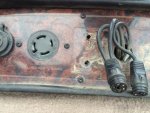What's need here is to determine if there three or four wires (two pairs - one pair for each battery) running up to the trolling motor receptacle at the bow. I'm betting, based on the year of the boat, that this is indeed a 4-wire system. If so, there is no reason to modify this very simple, very proper' and very current 4-wire 12/24 system for a very inefficient three wire 12/24 system. If you no longer have the plug or the jumper strap inside the plug, you can simply buy the matching plug at right here on ioats. The plug is marked for connection of the troller wires and the jumper strap
The current system has two batteries dedicated to the trolling motor whether it is 12 volt, 24 volt, or a combo 12/24 unit. Each battery has a separate pair of wires running up front. The trolling motor plug (the one on the troller cable) has a jumper strap inside it originally but it may no longer be there depending on the configuration of the original motor. For straight 24 volt operation, that strap would create the same connection a jumper between battery #1 positive and battery #2 negative in a three wire system. If the motor had a 12/24 selector switch, that jumper would not be used. Straight 12 volt and straight 24 volt motors only have two wires in the motor power cable. A dual voltage 12/24 motor will have three. The two troller batteries in this system are dedicated 12 volt circuits going to the troller receptacle on the panel. Leave these as they are. The Troller #1 and Troller #2 are circuit breakers to protect those two battery runs. The number 40 is the amperage of the two troller battery breakers. The 20 amp breaker is for the +12 volt feed from the STARTING battery to the fuse/breaker panel at the helm. The red plug/black plug note was for an accessory plug that you likely no longer have.
The red charge plug was intended to be attached to the battery charger leads so you could charge both batteries through the trolling motor receptacle rather than attaching directly to the batteries. If you have the original trolling motor plug, transfer it to the new motor with the strap in the 24 volt position. Connect the batteries and go fishing. When you connect the four wires to the batteries, make sure you have the positive and negative paired properly. Those wires are typically paired (sort of like typical lamp cord) so there should be no problem keeping them sorted. It doesn't matter which pair goes to which battery.






















